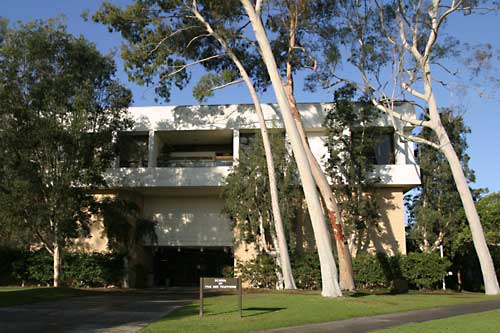
 |
jescom | meetings | documents | links | sjweb |
Loyola Marymount University
School of Film and Television<
October 2004

Both the school of film and television and the college of communication and fine artshave large numbers of students--teachers in each program proudly told me that their school was the largest at LMU-and occupy prime real estate in the heart of the campus in West Los Angeles. LMU has grown tremendously in the past decade or so, and the administration has given communication an important role in the plans for the university's growth.
The College of Communication and Fine Arts offers students a liberal arts core curriculum and a broad opportunity for creativity in scripts, plays, songs, paintings, ceramics, dance, multimedia designs, jewelry, recordings, photography, debate cases, legal briefs, public speeches, and critical reviews. Facilities include classrooms, studios, a gallery, recital hall and theater.
The School of Film and Television has its own building, with two floors above ground and a full basement. They have two large sound stages, one of which is set up for multi-camera TV production, as well as a smaller multi-camera studio in the basement. They have one well-equipped sound studio and a number of smaller rooms each of which has a sound editing computer system. They have one large digital video editing room with around 20 workstations, and another 8 or so smaller editing rooms in the basement. They have a good movie screening room and a few multi-media ready classrooms. There are around 150 students in the three-year-long MFA program, which has three tracks: screenwriting, TV and film.
Two Jesuits currently teach on the faculty, Father Luis Proenca from Portugal and Father Pat Connolly (a veteran of many years). Proenca did an MFA at LMU before returning to Portugal where he helped establish a department of communication at the Catholic University in Porto. Six years ago he came back to Los Angeles and joined the faculty at LMU. He has been able to continue producing his own projects by carving out some time during the academic year and then devoting his full time during the summer. He took three years to make a documentary on Portuguese immigrants in Hawaii. It was widely aired on TV and a four-DVD box of the original interviews is now being sold to libraries. He also did a documentary on refugees from Mozambique who fled to Malawi. His latest project concerns missions in California.
They have about twice as many part-time faculty as full-time, and draw them from working professionals in Hollywood. The school has been growing steadily, but they don't want to grow much bigger. The next step will be to improve equipment and develop the program. The other two film schools in town (USC and UCLA) are much bigger, but their students don't have as much chance do their own projects. Loyola students get the chance to try their hands at all phases of movie-making and get more hands-on experience.